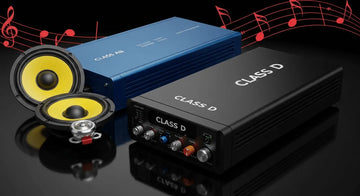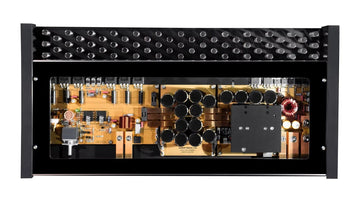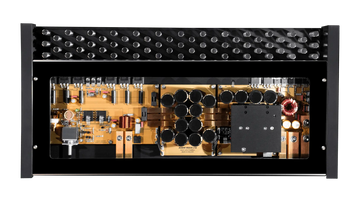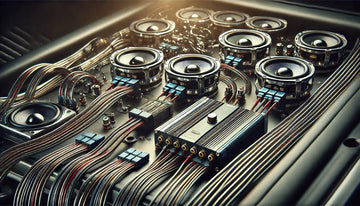6 Channel Amplifiers
Featured Products
Audio Wave Aspire Pro 6 Channel Amplifier | Previous Demo
US Acoustics Lanna | 6 Channel Class AB Amplifier | 6 x 150w
All products loaded
Discover the Power of a 6 Channel Car Amplifier for Your Audio System

If your car's factory sound system fails to do your music justice, you're not alone. The path from muddy, lifeless audio to a rich, immersive soundscape typically involves one critical component: a dedicated amplifier. For discerning listeners who demand ultimate control and audio fidelity, the 6 channel car amplifier is the heart of a truly high-end system. This single unit offers the power and flexibility to drive your entire speaker setup—from front to back, including a subwoofer—with precision and clarity. This guide will help you understand, select, and appreciate the transformative impact of a premium 6 channel amp and unlock your audio system's full potential.
Why a 6 Channel Amplifier is Essential for Premium Car Audio
A 6 channel amplifier car audio unit is a powerhouse designed to independently power up to six separate channels. While 2- and 4-channel amps are excellent for basic upgrades, a six-channel model provides the versatility needed for complex, high-fidelity configurations. This means every speaker in your car—front tweeters, mid-range drivers, rear speakers, and even a subwoofer—can receive its own dedicated stream of clean power. This is the core advantage of a 6ch car amplifier, delivering several key benefits to your listening experience.
-
Enhanced Sound Quality: The small, built-in amplifier in your car's head unit struggles to deliver clean power, especially at higher volumes, leading to distortion and a "flat" sound. A dedicated six channel car amp bypasses this weak link, feeding each speaker a robust, unclipped signal. The result is a dramatic improvement in clarity, dynamic range, and overall detail, allowing you to hear subtle nuances in your music that were previously inaudible.
-
Optimal Speaker Performance: High-quality aftermarket speakers are engineered to handle more power than a factory stereo can supply. Without sufficient power, they are underutilized and cannot perform as intended. A 6-channel amplifier for car ensures each speaker receives the proper RMS wattage, allowing it to reproduce sound with precision. This translates to tighter bass, crisper highs, and a more balanced, accurate soundstage.
-
Unmatched System Flexibility: A six channel car amplifier opens up a world of configuration possibilities. You can run a full 3-way active front stage (tweeter, midrange, and midbass drivers each on their own channel) for precise tuning. Alternatively, you can power a front component set (2 channels), rear coaxial speakers (2 channels), and bridge the last two channels to drive a powerful subwoofer. This single-amp solution simplifies wiring while providing total control over your system.
-
Improved Bass Response: While many systems use a separate monoblock amp for a subwoofer, a quality 6 channel car amplifier can power a sub effectively. By bridging channels 5 and 6, you combine their output to drive a subwoofer with authority. This ensures the bass is not just loud, but also tight, accurate, and musical, integrating seamlessly with your other speakers rather than sounding boomy or disconnected.
Unlike a 4-channel amplifier, which may force compromises like running rear speakers off the head unit or adding a second amp for a subwoofer, a car audio amplifier 6 channel model offers a more elegant, integrated, and capable solution for a complete system upgrade.
Choosing the Best 6 Channel Car Amplifier: Key Factors
Selecting the best 6 channel car audio amplifier requires looking beyond marketing claims. For the knowledgeable enthusiast, understanding the specifications is key to matching an amplifier to your speakers and achieving your audio goals. Let's break down the critical factors to ensure you make an informed investment.
Power Ratings (Watts)
Power is the most discussed amplifier spec, but it's also the most frequently misunderstood. The only number that truly matters is RMS (Root Mean Square) power, which represents the continuous, real-world power an amplifier can deliver. Ignore "Peak" or "Max" power ratings, as they describe brief, unsustainable bursts. For optimal performance, match the amplifier's RMS output to your speakers' RMS power handling rating. For instance, if your speakers handle 75W RMS, an amp delivering 75-90W RMS per channel is ideal. Also, check the six channel amp watts at different impedance loads (ohms). Most car speakers are 4-ohm, but many amps are stable at 2-ohms and deliver more power at that lower impedance. Ensure your chosen amp provides the right power for your specific speakers.
Amplifier Class
An amplifier's "class" defines its internal design, which affects its efficiency, heat generation, and physical size. The two most common classes are:
-
Class A/B: Long considered the benchmark for sound quality, Class A/B amplifiers are prized for their smooth, warm, and accurate sound, particularly in the mid and high frequencies. Their main drawback is lower efficiency (around 50-60%), meaning they generate more heat and require larger heat sinks and a bigger chassis. They remain an excellent choice for powering component speakers where audio purity is the highest priority.
-
Class D: Modern Class D amplifiers have evolved significantly and now dominate the market. They are extremely efficient (often 90% or more), enabling them to produce tremendous power from a compact chassis with minimal heat. While early designs were criticized for sound quality, contemporary full-range Class D models offer performance that rivals Class A/B, making them an outstanding all-around choice for a 6-channel car amplifier, especially where installation space is limited.
Key Features and Controls
A great amplifier provides the tools needed to properly tune your system. Look for a robust feature set, including comprehensive crossovers. High-pass filters (HPF) prevent low frequencies from damaging smaller speakers, while low-pass filters (LPF) direct only bass notes to a subwoofer. A band-pass filter (BPF) is ideal for mid-range drivers in an active setup, as it allows only a specific frequency range to pass through. Adjustable gain controls are essential for matching the amp's input to your head unit's output signal to prevent distortion. Other valuable features include bass boost for added punch and speaker-level inputs for integrating the amp with a factory stereo that lacks RCA outputs.
Size and Installation
Finally, consider the physical constraints of your vehicle. Measure the area where you plan to install the amplifier, such as under a seat or in the trunk. A compact Class D 6ch car amplifier may be your only option for a tight space. Remember that all amplifiers require adequate airflow to dissipate heat, so avoid cramming it into an unventilated location. Planning the physical placement of your amp is just as important as choosing the right technical specifications.
Installation and Setup Considerations for Your Six Channel Car Amplifier
Once you've chosen the perfect 6 channel amplifier for car audio, proper installation and tuning are what will bring your system to life. While professional installation is always recommended for newcomers, understanding the process helps you ensure the job is done correctly. A clean installation is critical not just for aesthetics, but for performance, reliability, and safety.
Wiring and Power
An amplifier is a high-current device that demands a steady supply of power to perform correctly. This begins with using the proper gauge power and ground wires. Wires that are too thin can starve the amplifier, limiting its output and creating a serious fire hazard. Your amplifier's manual will specify the recommended wire gauge based on its current draw and the wire length. An in-line fuse must be installed on the main power wire, as close to the battery as possible, to protect your vehicle. A solid, paint-free connection to the vehicle's chassis for the ground wire is equally vital for a noise-free, safe system.
Speaker Wiring and Impedance
With a six channel car amplifier, you have numerous wiring options. It is crucial to connect each speaker to the correct channel and observe proper polarity (+ and -). Reversing the polarity on even one speaker can cause phase cancellation, resulting in weak bass and a poor stereo image. Furthermore, respecting the amplifier's impedance rating is non-negotiable. Connecting speakers in a way that creates an impedance load lower than the amplifier's stable rating (e.g., a 2-ohm load on an amp rated for 4-ohms minimum) will cause it to overheat and eventually fail. Always double-check your speaker's impedance and your amp's stability ratings.
Tuning and Crossover Settings
Proper tuning is just as important as the physical installation. The first step is to set the gain controls correctly. The gain is not a volume knob; its purpose is to match the amplifier's input sensitivity to the head unit's output voltage. Setting the gain too low limits your system's potential, while setting it too high introduces clipping and distortion that can quickly destroy your speakers. After setting the gains, you will adjust the crossovers. Set the high-pass filter for your main speakers to block deep bass they cannot reproduce, and set the low-pass filter for your subwoofer channel to ensure it only plays low-frequency notes. This tuning process ensures every part of your 6 channel amplifier car audio system works in harmony to create a cohesive and powerful soundstage.
Frequently Asked Questions About 6 Channel Amplifiers
To help clarify your decision, here are answers to some of the most common questions about 6 channel amplifiers.
Q: What is the difference between a 4-channel and a 6 channel amp?
A: The primary difference is the number of outputs. A 4-channel amp typically powers front and rear speakers. A 6 channel amp adds two more channels, offering far greater flexibility. These extra channels can power a third pair of speakers, enable a 3-way active front stage, or be bridged together to power a subwoofer, often eliminating the need for a second amplifier.
Q: Can a 6 channel amplifier power a subwoofer?
A: Yes, and this is one of its key advantages. A popular configuration is to use four channels for front and rear speakers, then bridge the remaining two channels (5 and 6) into a single, more powerful mono channel to drive a subwoofer. Always check the amplifier's manual to confirm it is bridgeable and to verify its bridged power rating at a specific impedance.
Q: How much does a 6 channel car amplifier price typically range?
A: The 6 channel car amplifier price varies widely, from a couple hundred dollars to over a thousand. The cost is driven by factors like brand reputation, RMS power output, amplifier class (Class D is often more cost-effective for its power), and advanced features like built-in digital signal processing (DSP). Generally, a higher investment yields more power, superior sound quality, and greater tuning flexibility.
Q: Are 6 channel amplifiers difficult to install?
A: The installation of a 6 channel amplifier car audio unit is more complex than a 2- or 4-channel setup due to the increased number of speaker connections and advanced tuning options. While it's a manageable project for someone experienced in car audio, the complexity can be daunting for a novice. For the safest and best results, professional installation is recommended.
Q: What are some reputable brands for a 6 channel amplifier car audio system?
A: The car audio market includes many excellent brands known for quality and performance. When searching for 6 channel amplifiers for car audio, you will find respected names like JL Audio, Rockford Fosgate, Alpine, Kenwood, and Hertz. Each brand has a unique sound signature, so we recommend researching reviews and specifications to find the best fit for your budget and audio goals.
Find Your Ideal 6 Channel Amplifier for Sale Today
Upgrading to a 6-channel car amplifier is one of the most impactful steps you can take toward an immersive and powerful in-car listening experience. By delivering clean, dedicated power to every speaker, you unlock a level of clarity, detail, and impact that a factory system cannot provide. The flexibility to run a fully active front stage or a complete front, rear, and subwoofer system from a single chassis makes it the ultimate command center for your sound.
As you've learned, choosing the right model means focusing on the specifications that matter: clean RMS power matched to your speakers, an amplifier class suited to your space and audio preferences, and the crossover features needed to tune your sound perfectly. Whether you are building a system from scratch or upgrading an existing one, the right 6-channel amp will serve as the foundation for incredible audio for years to come.
Ready to take control of your car's sound? Browse our curated selection of 6 channel amplifiers for car audio from the industry's most trusted brands. Compare power ratings, features, and prices to find the perfect 6 channel amplifier for sale that meets your specific needs. Take the next step toward the high-fidelity sound system you've always wanted and elevate every moment you spend on the road.
Related Collections
6 Channel Amplifiers
Frequently Asked Questions
What is a 6-channel amp used for?
Can you run 6 speakers off a 4-channel amp?
Can a car amplifier improve sound quality?
What should you not do with a 6-channel amplifier?
What is the best 6 channel amplifier for car?
Related Articles

Class AB vs Class D Amplifiers: Which One Should You Choose?

The Best Class A Amplifier: Key Features and Benefits Explained

Class A Car Amplifiers: The Gold Standard in Sound Quality






